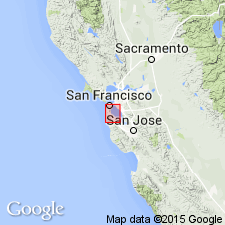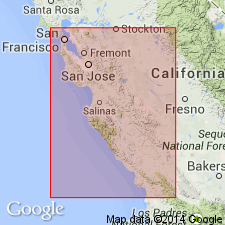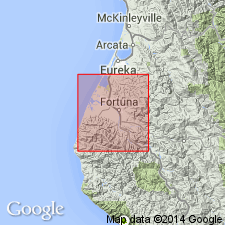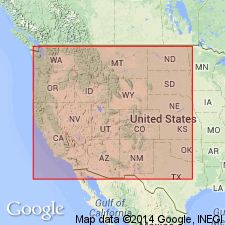
- Usage in publication:
-
- Franciscan series
- Modifications:
-
- Original reference
- AAPG geologic province:
-
- Santa Cruz basin
Summary:
Pg. 415; Amer. Geol., v. 15, p. 347, 1895. Franciscan series. Several thousand feet of sedimentary and volcanic rocks with which are associated various basic intrusives, notably perioditite serpentines. Is of either Cretaceous or Jurassic age. Includes foraminiferal limestones, great formations of peculiarly bedded radiolarian cherts, and certain highly crystalline schists. The San Francisco sandstone is dominant sedimentary formation of series. In vicinity of San Pedro Point a basal formation of conglomerates, coarse grits, sandstones, shaly sandstones, shales, and argillaceous limestones is exposed.
[Named from extensive exposures at San Francisco, San Francisco Co., western CA.]
[When referring to the Franciscan series of Lawson (1895), please use informally. The practice of employing "Series" for lithostratigraphic or lithodemic nomenclature is now regarded as improper (see ACSN, 1961, 1970; NACSN, 1983, 2005, 2021). The term "Series" is applied formally only to chronostratigraphic units.]
Source: US geologic names lexicon (USGS Bull. 896, p. 769).

- Usage in publication:
-
- Franciscan formation*
- Franciscan group*
- Modifications:
-
- Overview
Summary:
The Franciscan rocks, which attain thickness of several thousand feet, are usually treated as a formation, but in San Francisco folio (USGS Geol. Atlas of the U.S., no. 193) they were divided into five named and mapped formations (descending): Bonita sandstone, Ingleside chert, Marin sandstone, Sausalito chert, and Cahil sandstone, the latter including Calera limestone member. The broader term San Francisco sandstone is no longer used. The intrusive serpentine is not a part of the formation. The Franciscan rests unconformably on granite, and is unconformably overlain by Knoxville formation. Age is Jurassic(?).
Named from extensive exposures at San Francisco, [San Francisco Co.], western CA.
Source: US geologic names lexicon (USGS Bull. 896, p. 769).
- Usage in publication:
-
- Franciscan-Knoxville group[/]
- Modifications:
-
- Revised
- AAPG geologic province:
-
- California Coast Ranges province
Taliaferro, N.L., 1943, Franciscan-Knoxville problem: American Association of Petroleum Geologists Bulletin, v. 27, no. 2, p. 109-219.
Summary:
Franciscan-Knoxville problem discussed. The unconformity between Franciscan and Knoxville, reported by many writers, is unsupported by field evidence. The Knoxville is herein regarded as upper phase of Franciscan. Since these names have become fixed in the literature, it is here suggested that name [/]Franciscan-Knoxville group be used for entire sequence.
[The use of a hyphen between undifferentiated geologic units is not considered proper notation (CSN, 1933).]
Source: US geologic names lexicon (USGS Bull. 1200, p. 1413-1416).

- Usage in publication:
-
- Franciscan
- AAPG geologic province:
-
- California Coast Ranges province
Summary:
Pg. 123-125 [preprint 1941]. In Oregon, the Franciscan overlies the Galice unconformably, and the Galice, both faunally and lithologically, is equivalent to the Mariposa, the age of which has been well established as Kimmeridgian and slightly older (Portlandian). In northern California, the Galice has been converted into slate, whereas the Franciscan is unmetamorphosed. In northern California, unmetamorphosed Franciscan occurs in proximity to Mariposa-Galice slates. Franciscan is therefore younger than Kimmeridgian. It is believed that the Franciscan does not extend below Portlandian or, at the lowest, the upper Kimmeridgian. Field evidence does not support theory of unconformity between Franciscan and "Knoxville."
Source: US geologic names lexicon (USGS Bull. 1200, p. 1413-1416).

- Usage in publication:
-
- Franciscan formation
- Modifications:
-
- Areal extent
- Dominant lithology:
-
- Graywacke
- AAPG geologic province:
-
- Eel River basin
Summary:
Pg. 12-16, pl. 1. Franciscan formation. Recognized in Eel River valley area, Humboldt County, northwestern California. Consists principally of massive graywacke, and a minor amount of platy dark-gray shale, red thin-bedded chert, dark-green greenstone-basalt, and glaucophane schist. Thickness 10,000(?) feet; base not exposed. In Fortuna quadrangle is in fault contact with Yager formation (new) and is overlain unconformably by Wildcat group [undivided]. Age is Late Jurassic.
Source: Publication; US geologic names lexicon (USGS Bull. 1200, p. 1413-1416).

- Usage in publication:
-
- Franciscan assemblage
- Modifications:
-
- Geochronologic dating
- AAPG geologic province:
-
- Santa Cruz basin
Summary:
Pg. 7, 8, geologic time scale (inside front cover). Franciscan assemblage. Two samples from a glaucophane-phengite schist, at Lat. 38 deg. 32 min. 00 sec. N., Long. 123 deg. 07 min. 00 sec. W., Cazadero quadrangle, Sonoma County, California, yielded K-Ar ages (glaucophane) of 130 +/-12 Ma (time of metamorphism) [Cretaceous] and 86 +/-8 Ma (anomalously young). One sample from a graywacke on Bruno Mountain, Lat. 37 deg. 40 min. 00 sec. N., Long. 122 deg. 26 min. 00 sec. W., San Francisco South quadrangle, San Mateo County, California, yielded a Pb-alpha age of 330 +/-35 Ma (zircon); a mixed age of source rocks [Devonian to Pennsylvanian]. Ages calculated using decay constants of Steiger and Jager, 1977 (Earth Planet. Sci. Letters, v. 36, p. 359-362).
Source: Publication.
For more information, please contact Nancy Stamm, Geologic Names Committee Secretary.
Asterisk (*) indicates published by U.S. Geological Survey authors.
"No current usage" (†) implies that a name has been abandoned or has fallen into disuse. Former usage and, if known, replacement name given in parentheses ( ).
Slash (/) indicates name conflicts with nomenclatural guidelines (CSN, 1933; ACSN, 1961, 1970; NACSN, 1983, 2005, 2021). May be explained within brackets ([ ]).

